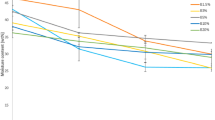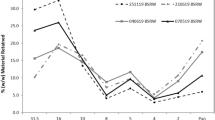Abstract
Although current trends address towards prevention strategies, the organic fraction of municipal solid waste is greatly produced, especially in high-income contexts. Its recovery-oriented collection is a common practice, but a relevant portion of the biodegradable waste is not source selected. Mechanical and biological treatments (MBT) are the most common option to sort and stabilize the biodegradable matter ending in residual waste stream. Following the changes of the framework around waste management, this paper aimed at analyzing the quality of the mechanically selected organic waste produced in MBT plants, in order to discuss its recovery options. The material performance was obtained by its composition as well as by its main chemical and physical parameters; biological stability was also assessed by both aerobic and anaerobic methods. On this basis, the effectiveness of an aerobic biostabilization process was assessed at pilot scale. After 21 days of treatment, results proved that the biomass had reached an acceptable biostabilization level, with a potential Dynamic Respirometric Index (DRIP) value lower than the limit required for its use as daily or final landfill cover material. However, the final stabilization level was seen to be influenced by scaling factors and the 21 days of treatment turned to be not so adequate when applied in the existing full-scale facility.







Similar content being viewed by others
References
Adani F, Tambone F, Gotti A (2004) Biostabilization of municipal solid waste. Waste Manage 24:775–783
ANPA (2000) Analisi merceologica dei rifiuti urbani. RTI CTN_RIF 1/2000.
AWWA-APHA-WEF (1998) Standard methods for the examination of water and wastewater, 20th edn. American Public Health Association/American Water Works Association/Water Environment Federation, Washington, DC, USA
Bari QH, Koenig A (2001) Effect of air recirculation and reuse on composting of organic solid waste. Resour Conserv Recy 33:93–111
Barrena R, Vázquez F, Sánchez A (2008) Dehydrogenase activity as a method for monitoring the composting process. Bioresour Technol 99:905–908
Barrena R, d’Imporzano G, Ponsá S, Gea T, Artola A, Vázquez F, Sánchez A (2009) In search of a reliable technique for the determination of the biological stability of the organic matter in the mechanical–biological treated waste. J Hazard Mater 162:1065–1072
Belgiorno V, Panza D, Russo L, Amodio V, Cesaro A (2011) Alternative stabilisation options of mechanically sorted organic fraction from municipal solid waste prior to landfill disposal. Int J Environ Eng 3(3–4):318–335
Borglin SE, Hazen TC, Oldenburg CM, Zawisianski PT (2004) Comparison of aerobic and anaerobic biotreatment of municipal solid waste. J Air Waste Manage Asoc 54:815–822
Casas O, López M, Quílez M, Martinez-Farre X, Hornero G, Rovira C, Pinilla MR, Ramos PM, Borges B, Marques H, Silva Girão P (2014) Wireless sensor network for smart composting monitoring and control. Measurement 47:483–495
Cecchi F, Traverso P, Pavan P, Bolzonella D, Innocenti L (2003) Characteristics of OFMSW and behaviour of the anaerobic digestion. In Mata Alvarez J (ed) Biomethanization of municipal solid waste, 1st edn. Padstow (UK), pp 141–179
Cesaro A, Belgiorno V, Guida M (2015) Compost from organic solid waste: quality assessment and European regulations for its sustainable use. Resour Conserv Recy 94:72–79
Chen Y, Cheng JJ, Creamer KS (2008) Inhibition of anaerobic digestion process: a review. Bioresour Technol 99:4044–4064
Colón J, Mestre-Montserrat M, Puig-Ventosa I, Sánchez A (2013) Performance of compostable baby used diapers in the composting process with the organic fraction of municipal solid waste. Waste Manage 33:1097–1103
Consonni S, Dainese C (2008) Tecnologie per il recupero di energia dai rifiuti solidi urbani. In Giugliano M. and Grosso M. (eds) Proceedings La gestione integrata dei rifiuti. 63° Corso di aggiornamento in Ingegneria Sanitaria-Ambientale, Milano, pp. XIII 1–36.
Denes J, Tremier A, Menasseri-Aubry S, Walter C, Gratteau L, Barrington S (2014) Numerical simulation of organic waste aerobic biodegradation: a new way to correlate respiration kinetics and organic matter fractionation. Waste Manage 36:44–56
Di Maria F, Micale C (2014) What is the acceptable margin of error for the oxygen uptake method in evaluating the reactivity of organic waste? Waste Manage 34:1356–1361
Di Maria F, Micale C (2015) Life cycle analysis of management options for organic waste collected in an urban area. Environ Sci Pollut R 22:248–263
El-Fadel M, Bou-Zeida E, Chahineb W, Alayli B (2002) Temporal variation of leachate quality from pre-sorted and baled municipal solid waste with high organic and moisture content. Waste Manage 22:269–282
FhG-IBP (2014) D 2.2 Waste profiling. http://www.waste2go.eu/. Accessed 29 June 2015
Getahun T, Nigusie A, Entele T, Van Gerven T, Van der Bruggen B (2012) Effect of turning frequencies on composting biodegradable municipal solid waste quality. Resour Conserv Recy 65:79–84
Günay A, Çetin M (2013) Determination of aerobic biodegradation kinetics of olive oil mill wastewater. Int Biodeterior Biodegradation 85:237–242
Gutiérrez MC, Martín MA, Serrano A, Chica AF (2015) Monitoring of pile composting process of OFMSW at full scale and evaluation of odour emission impact. J Environ Manage 15:531–539
Jayalakshmi S, Joseph K, Sukumaran V (2009) Bio hydrogen generation from kitchen waste in an inclined plug flow reactor. Int J of Hydrogen Energy 34:8854–8858
Juul N, Münster M, Ravn H, Ljunggren Söderman M (2013) Challenges when performing economic optimization of waste treatment: a review. Waste Manage 33:1918–1925
Kalemelawa F, Nishihara E, Endo T, Ahmad Z, Yeasmin R, Tenywa MM, Yamamoto S (2012) An evaluation of aerobic and anaerobic composting of banana peels treated with different inoculums for soil nutrient replenishment. Bioresour Technol 126:375–382
Kalamdhad AS, Pasha M, Kazmi AA (2008) Stability evaluation of compost by respiration techniques in a rotary drum composter. Resour Conserv Recy 52:829–834
Khalil A, Domeizel M, Prudent P (2009) Monitoring of green waste composting process based on redox potential. Bioresour Technol 99:6037–6045
Kolář L, Kužel S, Peterka J, Štindl P, Plát V (2008) Agrochemical value of organic matter of fermenter wastes in biogas production. Plant Soil Environ 54(8):321–328
Kolář L, Kužel S, Horáček J, Čechová V, Borová-Batt J, Peterka J (2009) Labile fractions of soil organic matter, their quantity and quality. Plant Soil Environ 55(6):245–251
Lesteur M, Bellon-Maurel V, Gonzalez C, Latrille E, Roger JM, Junqua G, Steyer JP (2010) Alternative methods for determining anaerobic biodegradability: a review. Process Biochem 45:431–440
López M, Soliva M, Martínez-Farré FX, Fernández M, Huerta-Pujol O (2010) Evaluation of MSW organic fraction for composting: separate collection or mechanical sorting. Resour Conserv Recy 54:222–228
López M, Martinez-Farre X, Casas O, Quilez M, Polo J, Lopez O, Hornero G, Pinilla MR, Rovira C, Ramos PM, Borges B, Marques H, Silva Girão P (2014) Intelligent composting assisted by a wireless sensing network. Waste Manage 34:738–746
Marousek J (2013) Two-fraction anaerobic fermentation of grass waste. J Sci Food Agric 93:2410–2414
Marousek J, Kondo Y, Ueno M, Kawamitsu Y (2013) Commercial-scale utilization of greenhouse residues. Biotechnol Appl Biochem 60(2):253–258
Marousek J (2014a) Biotechnological partition of the grass silage to streamline its complex energy utilization. Int J Green Energy 11:962–968
Marousek J (2014b) Economically oriented process optimization in waste management. Environ Sci Pollut Res 21:7400–7402
Marousek J, Zeman R, Vaníčková R, Hašková S (2014) New concept of urban green management. Clean Techn Environ Policy 16:1835–1838
Münster M, Ravn H, Hedegaard K, Juul N, Ljunggren Söderman M (2015) Economic and environmental optimization of waste treatment. Waste Manage 38:486–495
Nallathambi Gunaseelan V (1997) Anaerobic digestion of biomass for methane production: a review. Biomass Bioenergy 13(1/2):83–114
Pahl O, Firth A, MacLeod I, Baird J (2008) Anaerobic co-digestion of mechanically biologically treated municipal solid waste with primary sewage sludge—a feasibility study. Bioresour Technol 99:3354–3364
Ponsá S, Gea T, Alerm L, Cerezo J, Sánchez A (2008) Comparison of aerobic and anaerobic stability indices through a MSW biological treatment process. Waste Manage 28:2735–2742
Ponsá S, Gea T, Sánchez A (2010) The effect of storage and mechanical pretreatment on the biological stability of municipal solid wastes. Waste Manage 30:441–445
Ponsá S, Puyuelo B, Gea T, Sánchez A (2011) Modelling the aerobic degradation of organic wastes based on slowly and rapidly degradable fractions. Waste Manage 31:1472–1479
Puyuelo B, Gea T, Sánchez A (2014) GHG emissions during the high-rate production of compost using standard and advanced aeration strategies. Chemosphere 109:64–70
Robinson HD, Knox K, Bone BD, Picken A (2005) Leachate quality from landfilled MBT waste. Waste Manage 25:383–391
Rodríguez L, Cerrillo MI, García-Albiach V, Villaseñor J (2012) Domestic sewage sludge composting in a rotary drum reactor: optimizing the thermophilic stage. J Environ Manage 112:284–291
Ruggieri L, Gea T, Mompeó M, Sayara T, Sánchez A (2008) Performance of different systems for the composting of the source-selected organic fraction of municipal solid waste. Biosyst Eng 101:78–86
Salati S, Scaglia B, Di Gregorio A, Carrera A, Adani F (2013) The use of the dynamic respiration index to predict the potential MSW-leachate impacts after short term mechanical biological treatment. Bioresour Technol 128:351–358
Scaglia B, Adani F (2008) An index for quantifying the aerobic reactivity of municipal solid wastes and derived waste products. Sci Total Environ 394:183–191
Scaglia B, Confalonieri R, D’Imporzano G, Adani F (2010) Estimating biogas production of biologically treated municipal solid waste. Bioresour Technol 101:945–952
Scaglia B, Acutis M, Adani F (2011) Precision determination for the dynamic respirometric index (DRI) method used for biological stability evaluation on municipal solid waste and derived products. Waste Manage 31:2–9
Scaglia B, Salati S, Di Gregorio A, Carrera A, Tambone F, Adani F (2013) Short mechanical biological treatment of municipal solid waste allows landfill impact reduction saving waste energy content. Bioresour Technol 143:131–138
Sidelko R, Janowska B, Walendzik B, Siebielska I (2010) Two composting phases running in different process conditions timing relationship. Bioresour Technol 101:6692–6698
Sormunen K, Einola J, Ettala M, Rintala J (2008) Leachate and gaseous emissions from initial phases of landfilling mechanically and mechanically-biologically treated municipal solid waste residuals. Bioresour Technol 99:2399–2409
Sri Shalini S, Karthikeyan OP, Joseph K (2010) Biological stability of municipal solid waste from simulated landfills under tropical environment. Bioresour Technol 101:845–852
Sundberg C, Franke-Whittle IH, Kauppi S, Yu D, Romantschuk M, Insam H, Jönsson H (2011) Characterisation of source-separated household waste intended for composting. Bioresour Technol 102:2859–2867
Tambone F, Scaglia B, Scotti S, Adani F (2011) Effects of biodrying process on municipal solid waste properties. Bioresour Technol 102:7443–7450
Wimmer B, Hrad M, Huber-Humer M, Watzinger A, Wyhlidal S, Reichenauer TG (2013) Stable isotope signatures for characterising the biological stability of landfilled municipal solid waste. Waste Manage 33:2083–2090
Wu H, Zhao Y, Long Y, Zhu Y, Wang H, Lu W (2011) Evaluation of the biological stability of waste during landfill stabilization by thermogravimetric analysis and Fourier transform infrared spectroscopy. Bioresour Technol 102:9403–9408
Zhang R, El-Mashad HM, Hartman K, Wang F, Liu G, Choate C, Gamble P (2007) Characterization of food waste as feedstock for anaerobic digestion. Bioresour Technol 98:929–935
Acknowledgments
The authors wish to thank Paolo Napodano for his technical support.
Author information
Authors and Affiliations
Corresponding author
Additional information
Responsible editor: Gerald Thouand
Rights and permissions
About this article
Cite this article
Cesaro, A., Russo, L., Farina, A. et al. Organic fraction of municipal solid waste from mechanical selection: biological stabilization and recovery options. Environ Sci Pollut Res 23, 1565–1575 (2016). https://doi.org/10.1007/s11356-015-5345-2
Received:
Accepted:
Published:
Issue Date:
DOI: https://doi.org/10.1007/s11356-015-5345-2




